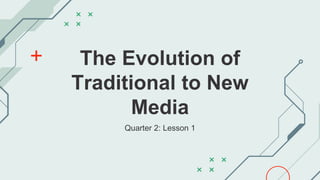
MIL_Lesson 6_Evolution of Media.pptx
- 1. The Evolution of Traditional to New Media Quarter 2: Lesson 1
- 2. Objectives At the end of this lesson, you are expected to:. 1. identify traditional media and new media, and their relationships; 2. explain how the evolution of media shapes the values and norms of the people in the society; 3. recognize the devices used by people to communicate with each
- 3. In the past, only televisions, radios, and newspapers were eligible for use. People communicated and shared information across the mainstream media. However, as the Internet expanded and evolved, people started to move from traditional media to new (digital) media. The convenience of Internet access attracts the public to use it over other media.
- 4. As a media and technology literate individual, you need to know where all the technology that you get comes from. You also have to understand how different media forms function.
- 5. 1. Where those media come from? 2. How in the past did the people connect without the use of media? 3. How did the media develop through the years? Question yourself
- 6. The Evolution of Media from Traditional to New (Digital) Media.
- 7. 1. Pre-Industrial Age (Before 1700) 2. Industrial Age (17005 to 19305) 3. Electronic Age (1930s-1980s) 4. New (Digital) Age (1900s-2000s) The Evolution of Media from Traditional to New (Digital) Media
- 8. People discovered fire, developed paper from plants, and forged equipment or weapon through stone, bronze, copper and iron. Example forms of media: Cave Painting (35,000BC), Clay tablets in Mesopotamia (2400BC), Papyrus in Egypt (2,500BC) Pre-Industrial Age (Before 1700)
- 9. People used the power of steam, developed machine tools, established iron production, and manufacturing of various products (including books through the use of printing press). Example forms of media: Telegraph (1830), Typewriter (1800), Telephone (1876), Printing Press for Mass Production (1900s), Motion Pictures (1890) Industrial Age (17005 to 19305)
- 10. • People harnessed the power of electricity that led to electrical telegraph, electrical circuits and the early large scale computers. • In this age, long distance communication became more efficient. Example forms of media: Transistor Radio (1947), Television (1941), Mainframe Computer (1960), OHP and LCD Projectors. Electronic Age (1930s-1980s)
- 11. • The use of microelectronics in the development of personal computers, handheld devices, and wearable technology advanced. In this era, the Internet paved the way for quicker communication and social network development. • Furthermore, voice, image, sound and data are digitalized. Example forms of media: Portable Laptop (1980), Friendster (2002), Internet Explorer, Skype (2003), Google 1997, Smart Phones, Digital Technologies. New (Digital) Age (1900s-2000s)
- 12. How the evolution of media shaped the norms and values of the people in the society?
- 13. Through the decades, the media's significant role in people's lives has grown. From simple task to disseminating information, the use of media has become diversified and personal. The invention of gadgets has redefined its values to its users.
- 14. Media is no longer just a source of information. Press is no longer a pure information source. It helps bridge the differences in cultural, political, and social matters. This ties people and nations together, and encourages reform, and develops innovations and community advancement.
- 16. 1. Inform Citizens of what is happening (Monitoring Function) 2. Educate the audience (meaning and significance of facts) 3. Provide a platform for public discourse (public opinion and expression of dissent) 4. “Watchdog” role of journalism 5. Channel for advocacy for political viewpoints Some of the media functions of media and communication.
- 17. Today, we have more outlets than ever before to get our news. Any of these have fundamentally changes how mainstream media options such as newspapers and television stations distribute news stories to us. Before we can watch updates on news through our television but today, we can have the same broadcast on social media platforms such as Facebook and Twitter. 1. Inform Citizens of what is happening (Monitoring Function)
- 18. Media offer awareness and information. They try to educate people directly or indirectly through different forms of content. However, media can become an instrument for the dissemination of false and inflammatory messages and values that do not promote respect or well-tempered dialogue and discussion. Negative messages can divide communities and can help perpetuate the stereotypes that nurture violence. 2. Educate the audience (meaning and significance of facts)
- 19. Mass media and other forms of information have a huge impact in influencing public sentiments and underlying feelings. Newspapers, televisions and radio are all essential source of basic knowledge about other people and different locations. 3. Provide a platform for public discourse (public opinion and expression of dissent)
- 20. The notion that the press works independently of the government is fundamental to this position. The watchdog is designed to prevent government from taking too much control from the people and violating their limits. The media also specializes in investigative reporting, which can reveal the risks of wrongdoings that the media may then disclose in order for the public to demand reform. 4. “Watchdog” role of journalism
- 21. Media inform and alert people with news and information to help them form their opinions about political issues and candidates. The web, however, has also been used to target people, mainly young users, to radicalize them into specific belief systems and divisive ways of seeing the world. 5. Channel for advocacy for political viewpoints
- 22. Media changes in the structure and control pose the question of whether the media still function as an impartial source of information. There are companies or CEOs already manipulating the flow of information, making profits more important than the unbiased distribution of information. But the reality is, media companies, whether it is a newspaper, television, radio or internet, are business. The company may find ways on how they can find revenues. 5. Channel for advocacy for political viewpoints
- 23. End…